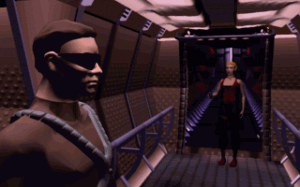Cyberia: Done
Zak, the player character in Cyberia, is a cyberpunk-as-interpreted-by-videogames sort of hero: a cool tough guy with computerized shades. His voice is permanently bored and his face never changes expression, or indeed shows any sign of being able to move his facial muscles at all, which is a bit of a problem for a kissing scene early on. And he kills and kills and kills. Once you’re in the Cyberia compound, leaving anything alive behind you generally means getting shot in the back. If you manage to slip by someone without killing them, it just means you’re going to have to kill them some other way later.
For the wandering-around-corridors segment of the game contains shooting of zap guns aplenty, usually in the form of shootouts where you and the enemy are popping out from cover repeatedly. This is one of the game’s few ways to keep repeatedly killing you in what would otherwise be a lightweight adventure-style situational puzzle sequence. Some puzzles require actions in more than one room, which is a bit of a strain on the checkpoint system, which is designed to just remember a location, not any state. The result is that the checkpoints can get pretty far apart here, with the result that any time I died, I needed to repeat multiple roomworths of content, including shootouts. Just a few days ago, I complained about the rapid die/retry cycle, but it’s even worse when it’s long.
Each floor of the compound is mostly just one big curving corridor with rooms hanging off it here and there, but in its favor, the place really is conceived as spatially coherent, and there are a couple of puzzles that rely on this. For example, one bit requires you to open a vent so you can reach through it from the other side, after going back the way you came and then coming back through some unusually spacious air ducts.
Also to its credit, the game does go slightly nonlinear here, with two entrances to the compound, one guarded by a guard with a gun, the other by something even more lethal: a spinning metal fan. (For some reason, videogame designers seem to think that fans are the most dangerous things on Earth. Even in a game where you can keep going after falling five stories and taking multiple bullets to the chest, touching a fan kills instantly.) Anyway, the guard route leads to one of those self-contained wall-panel puzzles that I liked so much. Unfortunately, that seems to be it for those puzzles. Just two in the entire game, and one of them is skippable.
We get more story in the compound than in the rest of the game put together, partly through snooping into the staff’s video emails. But the story is pretty much all cliché, including the genre-mandated betrayal of the hero by his employer. Why is this such a mainstay of the cyberpunk videogame? It wasn’t that big a part of literary cyberpunk.
Towards the end, there is more of the FMV swoop-and-shoot, but not in the way I had anticipated. In fact, you get three different contexts for it, two of which involve controlling a machine remotely, so that you’re playing the part of a person sitting and staring at a computer screen. The third, the climax of the game, involves becoming a sort of nanotech superman and flying off into space for the most direct Rebel Assault imitation yet. Space seems to me a better setting for this stuff than Earth, if only because it’s easier to render convincingly.
And that concludes Cyberia, a game that I didn’t want. I’ll say this for it: it’s a pretty pure specimen of its type. If someone asks “What were 90s FMV games like, and why are people so down on them?”, you can point them at Cyberia to answer both questions.
 Comments(4)
Comments(4)